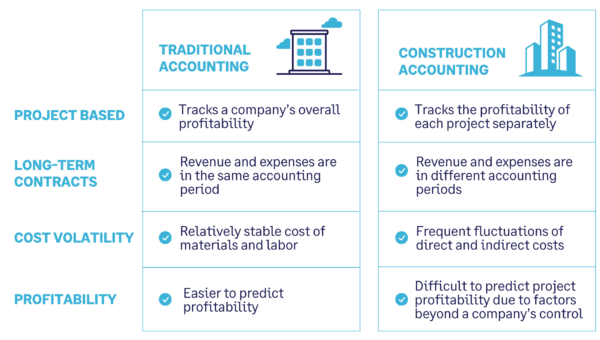Key Elements to Look for in Construction Accounting Software Tools
Key Elements to Look for in Construction Accounting Software Tools
Blog Article
Understanding Building Bookkeeping: Essential Tips for Financial Success in the Industry
Grasping building audit is a vital component for financial success within the sector, as it incorporates numerous methods that directly impact project success. Discovering these overlooked approaches may expose possibilities that could change your strategy to construction accountancy.
Recognizing Building Accountancy Fundamentals
Understanding the principles of building and construction audit is essential for reliable job monitoring and economic oversight in the construction sector. Construction accountancy differs considerably from conventional accountancy techniques as a result of the distinct challenges posed by project-based work, including variable prices, varying timelines, and complex governing requirements.
A key element of construction accounting is task costing, which involves tracking costs for each details project. This method enables professionals to accurately evaluate profitability and make notified economic decisions. Furthermore, building and construction accounting includes using development payment, where billings are issued based upon the percent of work completed, making sure capital is preserved throughout the project lifecycle.
Another essential element is the monitoring of modification orders, which stand for adjustments to the original contract scope. Proper documentation and accounting for these modifications are crucial to prevent monetary conflicts and make sure exact task budgeting.
Finally, recognizing the significance of conformity with sector laws and tax obligation requirements is paramount. Precise monetary reporting and adherence to bookkeeping standards not just secure versus legal issues but likewise enhance the integrity of building and construction firms. Mastering these basics establishes the structure for effective financial management within the building and construction sector.
Effective Project Budgeting Methods
Efficient project budgeting strategies are crucial for ensuring that building and construction jobs continue to be financially practical and on track. A well-structured budget offers as a roadmap, assisting task managers through the intricacies of building prices.
Following, using historic information from previous tasks can significantly improve the accuracy of budget plan quotes. By analyzing previous expenditures, groups can determine price patterns and potential challenges. In addition, involving stakeholders during the budgeting process fosters openness and safeguards buy-in, which can minimize conflicts later on.
On top of that, adopting a detailed line-item budget plan enables thorough tracking of prices related to materials, labor, and expenses. This granularity enables project managers to identify variations early and change approaches as necessary. In addition, incorporating contingency allowances within the budget plan can aid account for unanticipated costs, guarding the task against financial stress.
Last but not least, routine spending plan evaluates throughout the task lifecycle make certain that monetary objectives stay straightened with task goals, helping with timely treatments when essential. Executing these methods can considerably add to the financial health and success of building projects.
Streamlining Cost Tracking Processes
Precise cost monitoring procedures are important in the construction industry, as they regularly determine the financial success of a task. Efficient tracking enables task managers to monitor expenses in real-time, ensuring they continue to be within budget plan and can make informed choices quickly. To enhance these procedures, it is essential to embrace a methodical method that integrates modern technology and recognized methods.
First, making use of customized building and construction bookkeeping software application can automate information entry and reporting, decreasing human mistake and increasing performance. construction accounting. Such software program commonly consists of functions for tracking labor, products, and subcontractor prices, you can find out more supplying a thorough view of project expenditures
Second, standardizing procedures for recording expenses throughout jobs improves uniformity and simplifies evaluation. Establishing a clear graph of accounts tailored to the distinct demands of construction projects can assist in precise classification of expenditures.
Finally, routine training for staff on the value of exact price tracking and the tools made use of in the procedure promotes responsibility. By carrying out these techniques, building firms can dramatically enhance their expense tracking processes, causing boosted economic control and job productivity. Eventually, a well-structured approach to set you back tracking prepares for effective project administration and long-lasting economic sustainability.
Managing Capital Efficiently

On a regular basis monitoring capital statements is essential. By examining cash inflows and discharges, businesses can determine fads and possible shortfalls. This technique assists in timely modifications to investing or payment routines, preventing cash money scarcities that could threaten project timelines.

Finally, maintaining an economic pillow or credit line can give a safety internet during lean periods. Utilizing these methods will certainly lead to a more stable financial structure, allowing construction firms to navigate the market's inherent unpredictabilities with greater confidence.
Staying Clear Of Typical Accountancy Pitfalls
In the complicated landscape of building bookkeeping, avoiding typical mistakes is vital for maintaining financial integrity and task success. One common issue is inadequate record-keeping. Building and construction jobs typically entail various purchases, and falling short to document them correctly can result in discrepancies and economic losses. It is vital to execute a durable system for monitoring costs, labor, and materials.
Another challenge is the mismanagement of modification orders. Adjustment orders are an all-natural part of building projects, yet without correct accounting for these adjustments, firms might have a hard time to recover prices. Establishing a clear process for recording and accepting change orders can alleviate this threat.
In addition, overlooking to reconcile accounts frequently can result in inaccurate economic declarations and prevent decision-making. Normal reconciliation ensures that records line up with bank declarations and job paperwork.
Lastly, ignoring tax obligations can have serious repercussions. It is vital to stay notified regarding tax obligation guidelines certain to the construction industry, including sales tax obligation on materials and labor.
Conclusion
Mastering construction accountancy is vital for accomplishing economic success within the market. Focusing on conformity and resolving usual accounting risks strengthens integrity and sustains long-lasting profitability, ultimately fostering a sustainable affordable benefit in the construction market.
Report this page